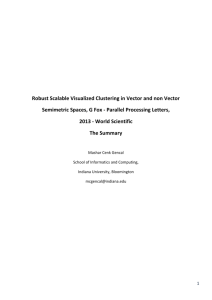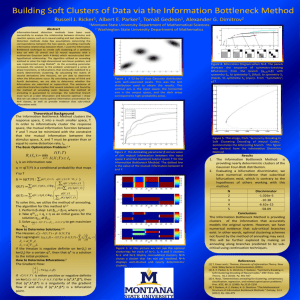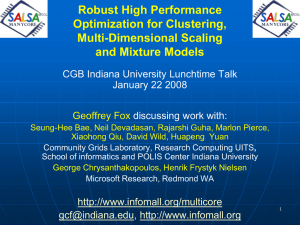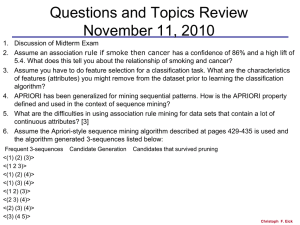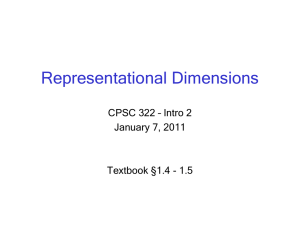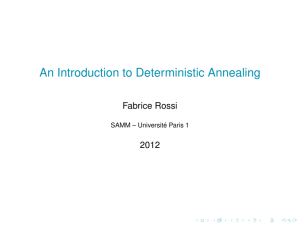slides - salsahpc - Indiana University
advertisement
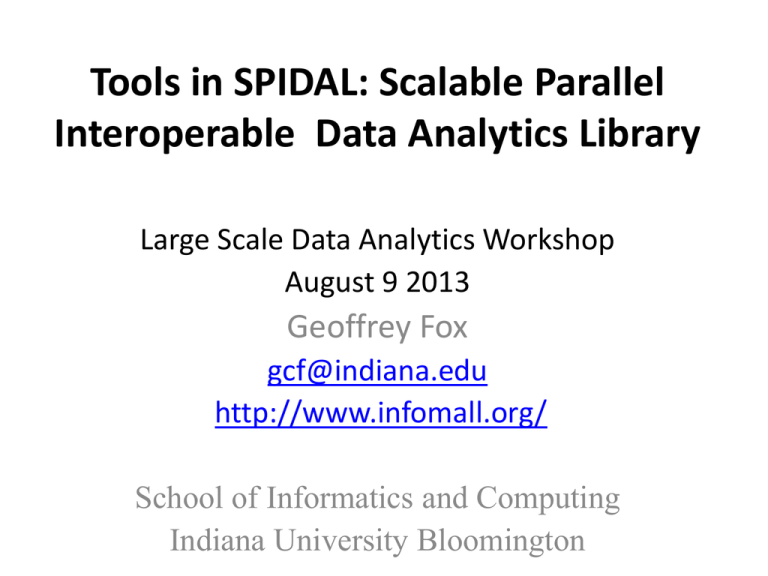
Tools in SPIDAL: Scalable Parallel
Interoperable Data Analytics Library
Large Scale Data Analytics Workshop
August 9 2013
Geoffrey Fox
gcf@indiana.edu
http://www.infomall.org/
School of Informatics and Computing
Indiana University Bloomington
Overview
• Higher level (but still low level tools) Capabilities
–
–
–
–
Biology Distance Calculations
Clustering
Dimension Reduction
Plotting – Point and Heat maps
• Mode
– Batch versus Online (Interpolative)
• Even Lower Level Capabilities
– Eigenvalue Solvers
– Conjugate Gradient Equation solvers
– Robust 2 Solver (Levenberg-Marquardt)
• Implementations http://beaver.ads.iu.edu:9000/
–
–
–
–
MPI and/or Iterative MapReduce run up to 1000 cores with MPI/Threading mix
Parallel Threading
Not much GPU
~75,000 lines of Java or C#
• Techniques
– Expectation Maximization (Steepest Descent)
– Deterministic Annealing to avoid local minima
– Second Order Newton solvers
• PS I have always worked on Optimization problems – first paper 1966
Multi-Dimensional Scaling
• Map general set of n points to d (typically 3) dimensions
– Map genomic/proteomic sequences to ~20D as alternative to
Multiple Sequence Alignment
• Original Data is vectors: Generative Topographic Map GTM
and Deterministic Annealing + GTM
• No vectors – only a distance metric d(Xi , Xj) : Classic MDS
with SMACOF and 2 versions: Minimize Stress
– (X) = i<j=1n weight(i, j) [(i, j) - d(Xi , Xj)]2
– (i, j) are input dissimilarities
• SMACOF has deterministic annealing version
– Recently added SMACOF for weight(i, j) 1; until this needed
slower 2 method for general problem
• Note O(n2) Objective function makes Newton’s method
effective because conjugate gradient makes O(n3) linear
equation solvers act as constant . O(n2) solver
• Interpolative (online) versions
Protein Universe Browser for COG Sequences with a
few illustrative biologically identified clusters
4
CoG
NW
Sqrt
(4D)
5
Clustering
• Vector Datasets O(N): Kmeans plus deterministic annealing
– Improved Elkans algorithm (Qiu)
– Continuous Clustering (solve for cluster density at a center)
– Trimmed (finite size) clusters
• Non-metric Spaces with only dissimilarities defined O(N2)
with deterministic annealing
• Deterministic Annealing (vector or non-vector) always
improves results but not always needed note
– DA does not need specification of # clusters
– Comes from early neural networks days (Hopfield, Durbin)
• Hierarchical algorithms (roughly built in with DA)
• Related algorithms Gaussian Mixture Models, PLSI
(probabilistic latent semantic indexing), LDA (Latent Dirichlet
Allocation) also with Deterministic annealing
~125 Clusters from Fungi sequence set
Non metric space
Sequences Length ~500
Smith Waterman
A month on 768 cores
7
Deterministic
Annealing
F({y}, T)
Solve Linear
Equations for
each temperature
Nonlinear effects
mitigated by
initializing with
solution at
previous higher
temperature
Configuration {y}
•
Minimum evolving as temperature decreases
•
Movement at fixed temperature going to false minima if
https://portal.futuregrid.org
not initialized “correctly
Basic Deterministic Annealing
• H is objective function to be minimized as a function of
parameters
• Gibbs Distribution at Temperature T
P() = exp( - H()/T) / d exp( - H()/T)
• Or P() = exp( - H()/T + F/T )
• Minimize Free Energy combining Objective Function and Entropy
F = < H - T S(P) > = d {P()H + T P() lnP()}
• Simulated annealing corresponds to doing these integrals by
Monte Carlo
• Deterministic annealing corresponds to doing integrals analytically
(by mean field approximation) and is much faster
• In each case temperature is lowered slowly – say by a factor 0.95
to 0.9999 at each iteration
• Start with one cluster, others emerge automatically as T decreases
https://portal.futuregrid.org
• Start at T= “” with 1
Cluster
• Decrease T, Clusters
emerge at instabilities
https://portal.futuregrid.org
10
https://portal.futuregrid.org
11
https://portal.futuregrid.org
12
Proteomics LC-MS 2D DA Clustering
T= 25000 60 Clusters
Number of Clusters
End
Start
Temperature
Proteomics 2D DA Clustering T=0.1
small sample of ~30,000 Clusters Count >=2
Orange sponge points
Outliers not in cluster
Yellow triangles
Centers
14
Clusters v. Regions
Lymphocytes 4D
Pathology 54D
• In Lymphocytes clusters are distinct
• In Pathology, clusters divide space into regions and
sophisticated methods like deterministic annealing are
probably unnecessary
15
Generalizing large Scale
2
• 2 = i=1N [t(i, x(k)) – e(i)]2
• “Just” an objective function to be minimized as a
function of x(k)
• Parallelism over i and k
• If you can calculate t(i)/x(k) (automatic compilers
available), then can either do
– “Steepest descent” x(k) = x0(k) – i=1N const t(i)/x(k)
guaranteed to decrease 2 but likely to get local minima
– “Newton’s method” solving second order Taylor expansion
always fails unless “regularize” but always succeeds with
good solver (maybe too slow though)
• Levenberg Marquardt regularizes i=1N t(i)/x(k)
t(i)/x(l) by adding multiple Q of unit matrix
– Solve equations by conjugate gradient ~ N (# parameters)2
– “Manxcat” (based on 1976 physics expt code) choses Q etc.
Overview
• Higher level (but still low level tools) Capabilities
–
–
–
–
Biology Distance Calculations
Clustering
Dimension Reduction
Plotting – Point and Heat maps
• Mode
– Batch versus Online (Interpolative)
• Even Lower Level Capabilities
– Eigenvalue Solvers
– Conjugate Gradient Equation solvers
– Robust 2 Solver (Levenberg-Marquardt)
• Implementations http://beaver.ads.iu.edu:9000/
–
–
–
–
MPI and/or Iterative MapReduce run up to 1000 cores with MPI/Threading mix
Parallel Threading
Not much GPU
~75,000 lines of Java or C#
• Techniques
– Expectation Maximization (Steepest Descent)
– Deterministic Annealing to avoid local minima
– Second Order Newton solvers
• PS I have always solved Optimization problems – first paper 1966
Future
• Scale to lots more cores and larger problems
(HPC, Azure …)
• Add GPU’s or MIC chip
• Lets look at other problems
• Bundle as easy to use services
• Choose best batch set for large batch + online run
– O(N2) O(N)
• Exploit cluster as well as point parallelism (similar
to better hierarchical method)
